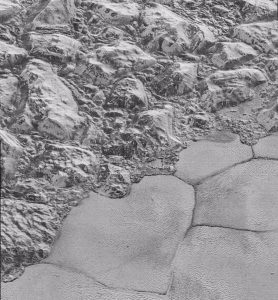
Before the New Horizons flyby, planetary scientist James Keane saw himself as a “Pluto skeptic.”
“I don’t know if I or anyone could have predicted that Pluto would be as interesting as it turned out to be,” he said.
Boy was he wrong. The distant dwarf planet is home to mysterious mountains that could be ice volcanoes and icebergs of water ice floating atop a plain of frozen nitrogen. Chief among Pluto’s fascinating – and endearing – features is its bright, white heart full of ice and nitrogen snow.
In one of two new papers on Pluto published Wednesday in the journal Nature, Keane and his colleagues write that the western lobe of this heart – an ice-filled impact basin called Sputnik Planitia – may have acted like an extra weight on one side of a bowling ball, causing the planet to wobble away from its original spin axis. A second study led by University of California – Santa Cruz planetary scientist Francis Nimmo suggests that Sputnik Planitia may be so heavy because an underground ocean is hiding beneath the planet’s icy crust.
Keane, a PhD student at the University of Arizona, and Nimmo were both immediately drawn to Sputnik Planitia (pronounced pla-NI-sha) because it is located at what’s called the anti-Charon point – the spot on Pluto’s surface that is directly opposite the side that faces Pluto’s largest moon. (Pluto and Charon are “tidally locked,” meaning that their orbits and rotations are synchronized so that one side of Pluto always faces Charon, and vice-versa.)
“We were struck initially that the brightest thing, the most anomalous thing, was at a special location on Pluto,” Keane said. “If you were to draw a line connecting the center of Charon through the center of Pluto it would come out on the far side of Pluto and it would go right throw Sputnik Planitia.”
This is suggestive of a phenomenon known as true polar wandering: The planet’s spin axis remains the same relative to the rest of the solar system, but the planet itself reorients so that its poles are at two new locations.
Imagine a desk globe in which the ball of the Earth itself could roll 360 degrees within the bracket, but the axis on which it rotates remains the same.
Pluto would reorient itself to situate Sputnik Planitia at the anti-Charon point if the basin was inordinately heavier than the rest of the dwarf planet – for complicated physics reasons, this orientation is what makes the lopsided planet most stable.
But, as Nimmo put it, “Sputnik Planitia is a hole in the ground. So normally you’d expect it to have less weight not more weight.”
Keane and Nimmo offer up different – but not necessarily contradictory – explanations for why Sputnik Planitia might be so heavy.
Keane and his colleagues note that Sputnik Planitia is full of volatile ices like nitrogen. Though these compounds would be gases on Earth, on Pluto it is so cold that they freeze and behave like glaciers, flowing ever so slowly. Pluto is also colder at low elevations than at high ones, so nitrogen and methane probably get trapped in Sputnik Planitia’s deep basin. And, crucial to this study, nitrogen ice is denser than the water ice that makes up the rest of Pluto’s crust. It would be as if Hudson Bay on Earth was full of iron rather than water.
Keane’s team found further evidence of Pluto’s polar wandering in the crusts that span the dwarf planet’s surface. Like all bodies with a moon, Pluto has what’s known as a tidal bulge at the latitude around which Charon orbits. As Pluto reoriented, the location of that tidal bulge would have shifted, fracturing the crust.
“Imagine trying to squish an egg so the widest part is in a different spot,” Keane said. “You’ll break the egg.”
The pattern of these breaks on Pluto indicate how its tidal bulge shifted – and matched up perfectly with Keane’s prediction of how Pluto may have reoriented.
Instead of examining what’s inside Sputnik Planitia, Nimmo and his colleagues studied what might be below it.
Data from New Horizons suggests that Pluto could have sloshing subsurface ocean of liquid water. The planet has cracks on its surface characteristic of the planet expanding and contracting as parts of that ocean melt and freeze.
If there is water in Pluto’s interior, then it would likely upwell beneath Sputnik Planitia, where the crust is thinner. That would make this spot heavier than the rest of the dwarf-planet, since liquid water is denser than ice.
It’s possible that neither of these theories fully explains Pluto’s polar wandering. For one thing, scientists haven’t conclusively proved that Pluto even has an interior ocean. For another, not all of the volatile ices that Keane discusses in his paper are heavier than water ice, so it’s difficult to know exactly how much heavier than the rest of Pluto Sputnik Planitia might really be.

“In reality, as with all these things, I suspect its really a combination of both processes,” Keane said.
The “gold standard” for testing these hypotheses would be to do gravity testing of Pluto, he added, but that would require another mission to the far-flung dwarf planet. Considering it took New Horizons 10 whole years to reach Pluto, such a mission isn’t likely to happen anytime soon.
In the meantime, Pluto’s longtime devotees – and newfound fans like Keane – will find plenty to work with amid the 6.25 gigabytes of data sent back by New Horizons.
“Every time I look at an image of Pluto, even if it’s something I’ve seen 100 times before, like Sputnik Planitia, there’s always something new that sticks out,” Keane said. “I think it’s going to keep planetary scientists extremely busy for a long time.”
(c) 2016, The Washington Post · Sarah Kaplan

